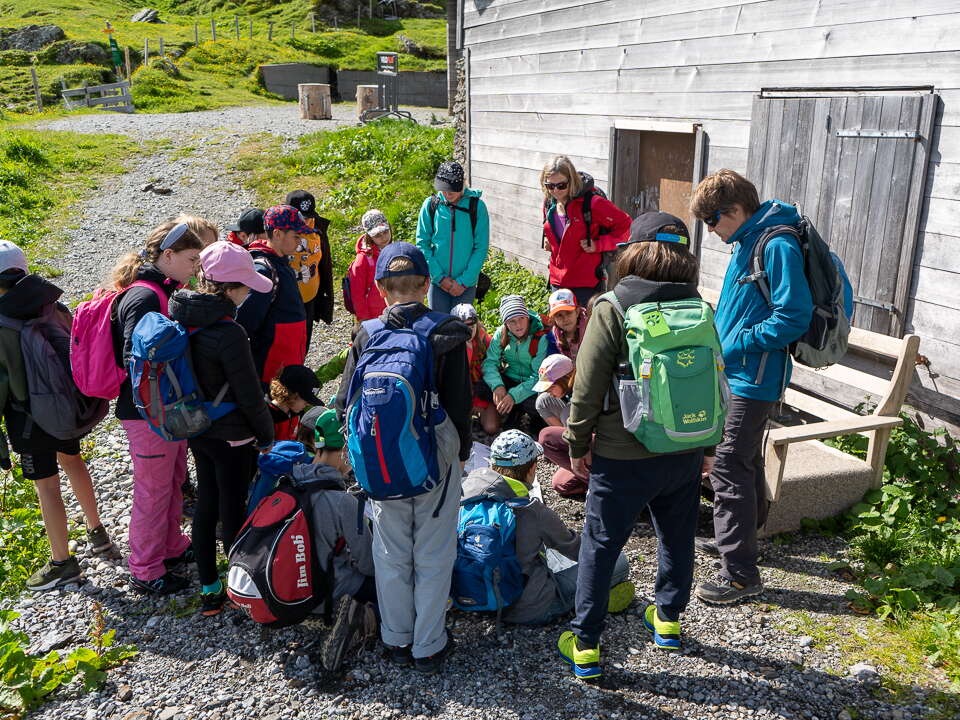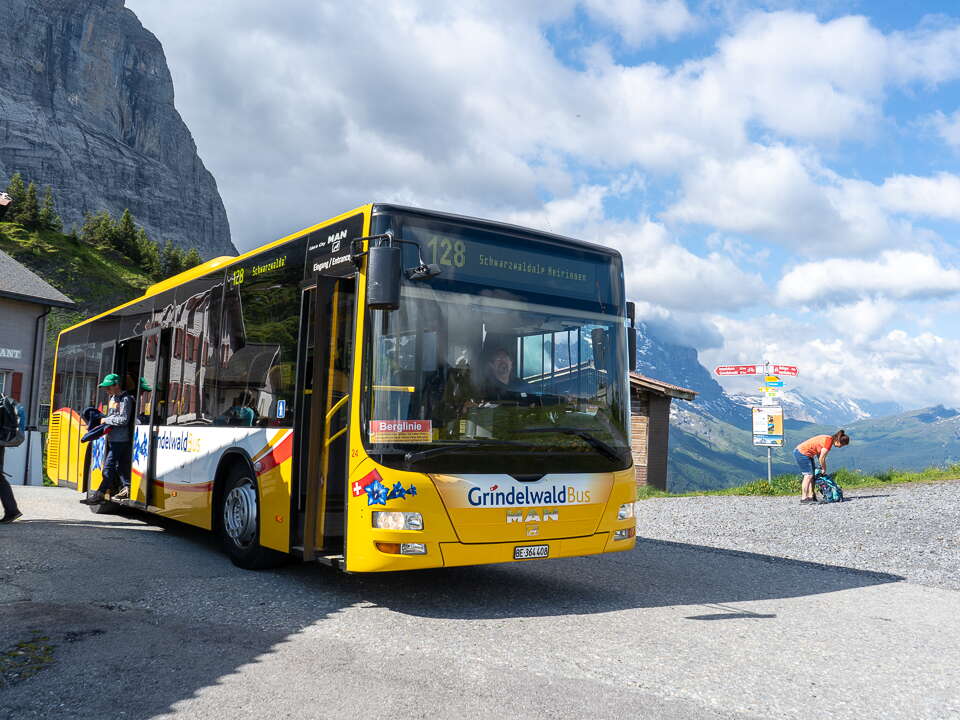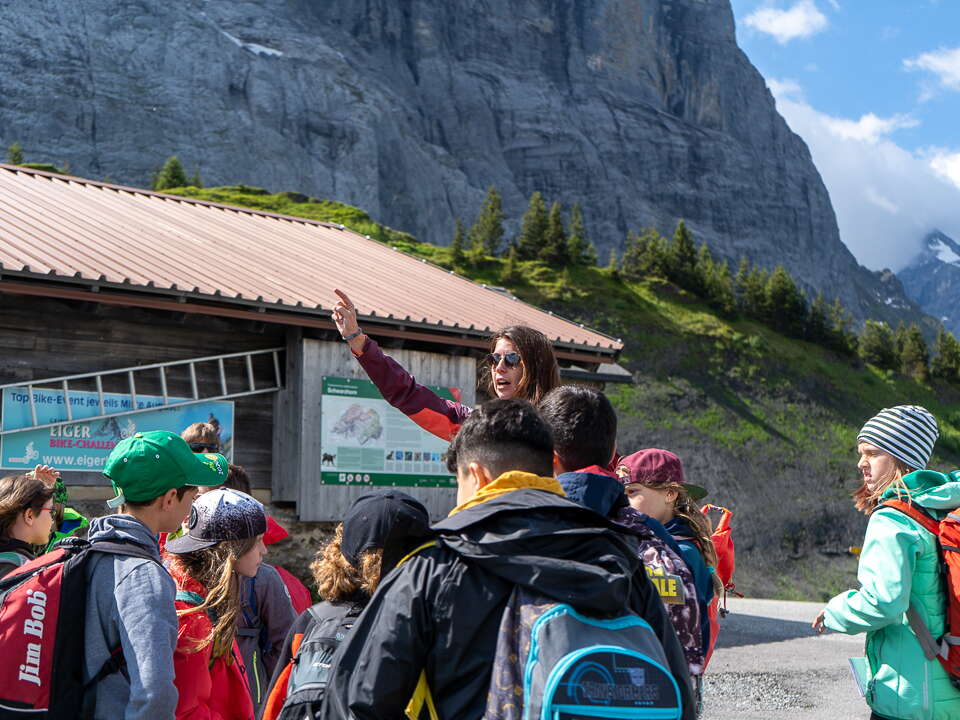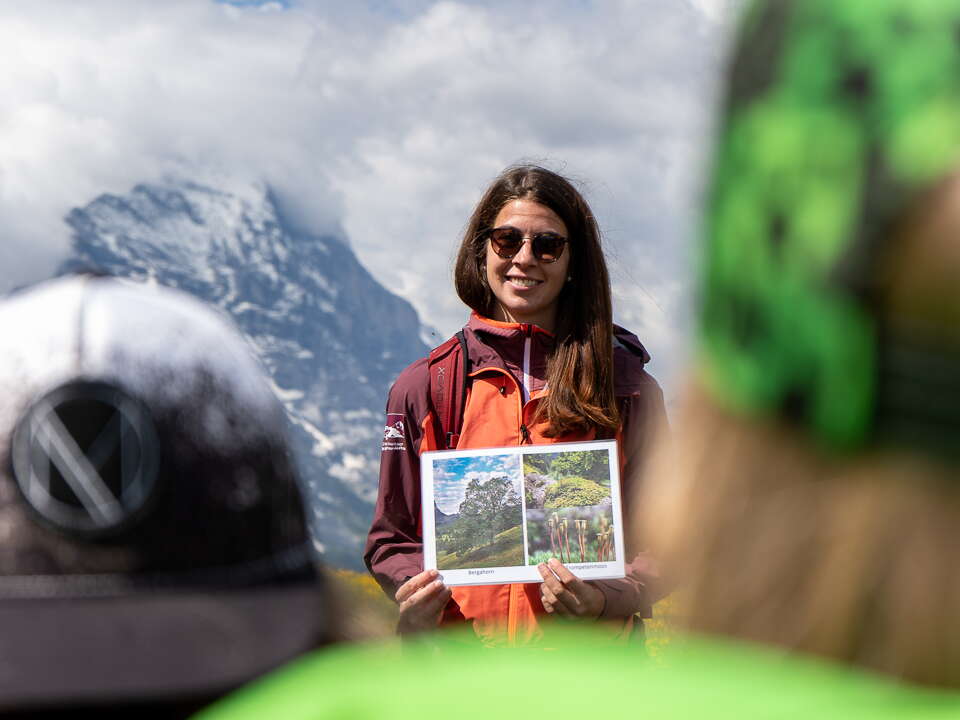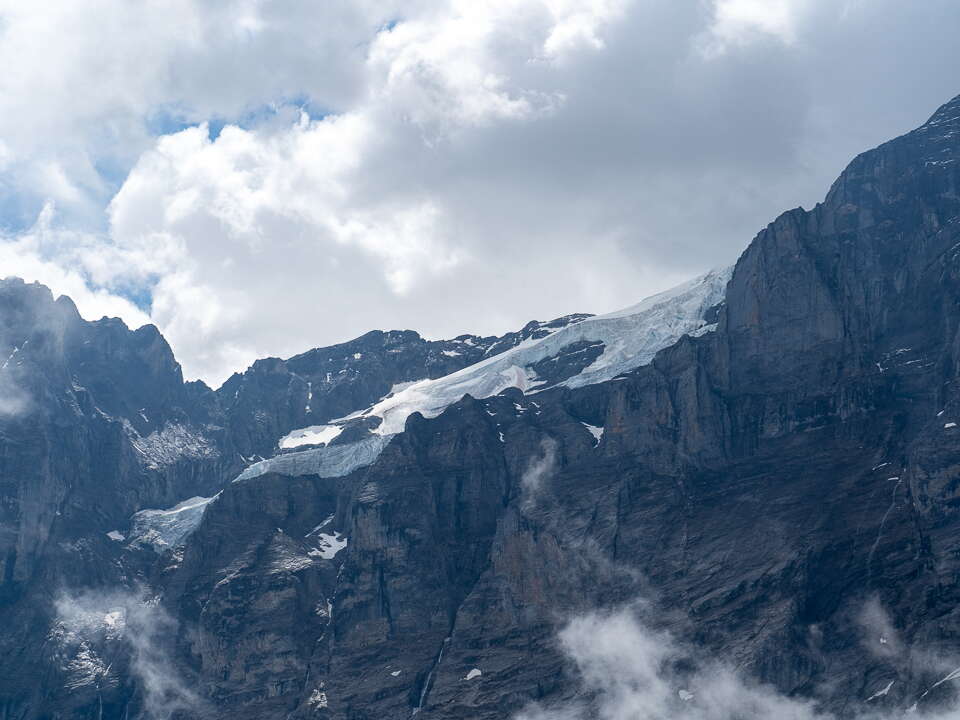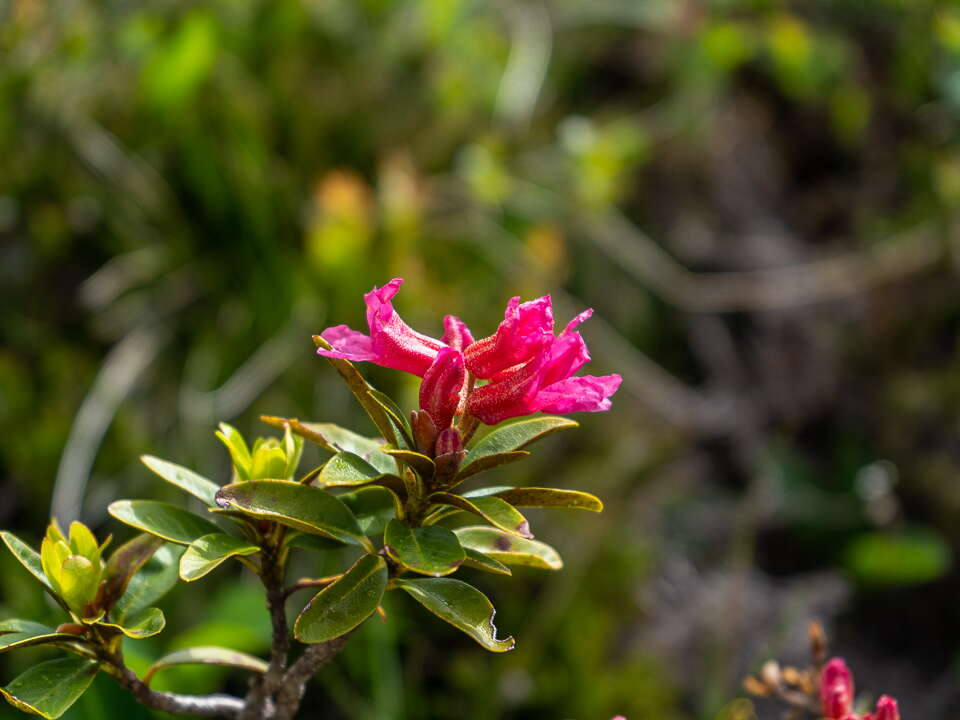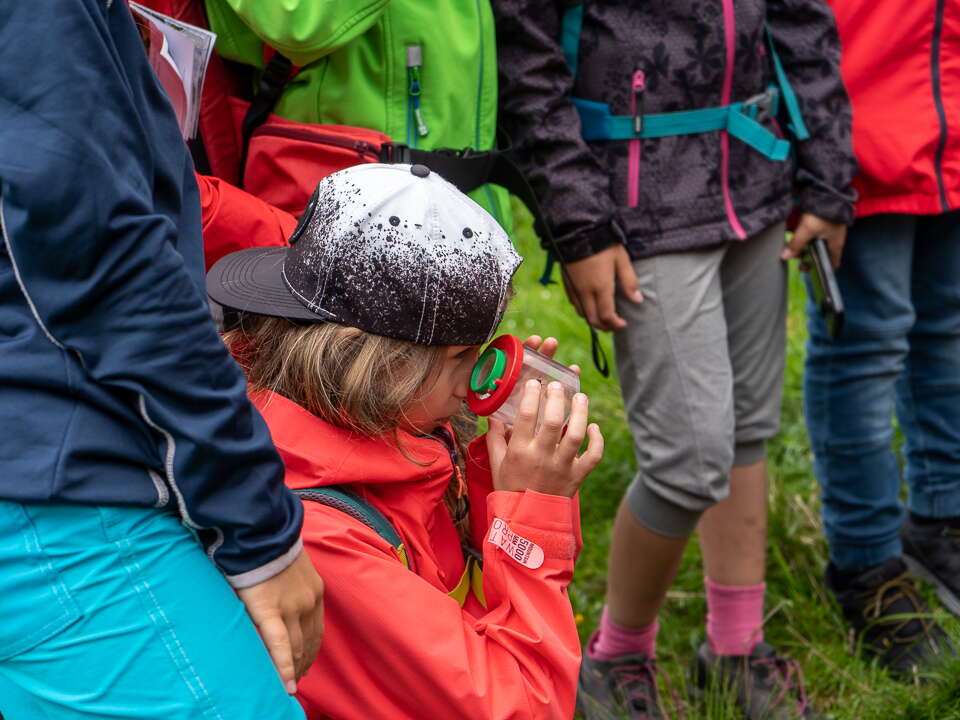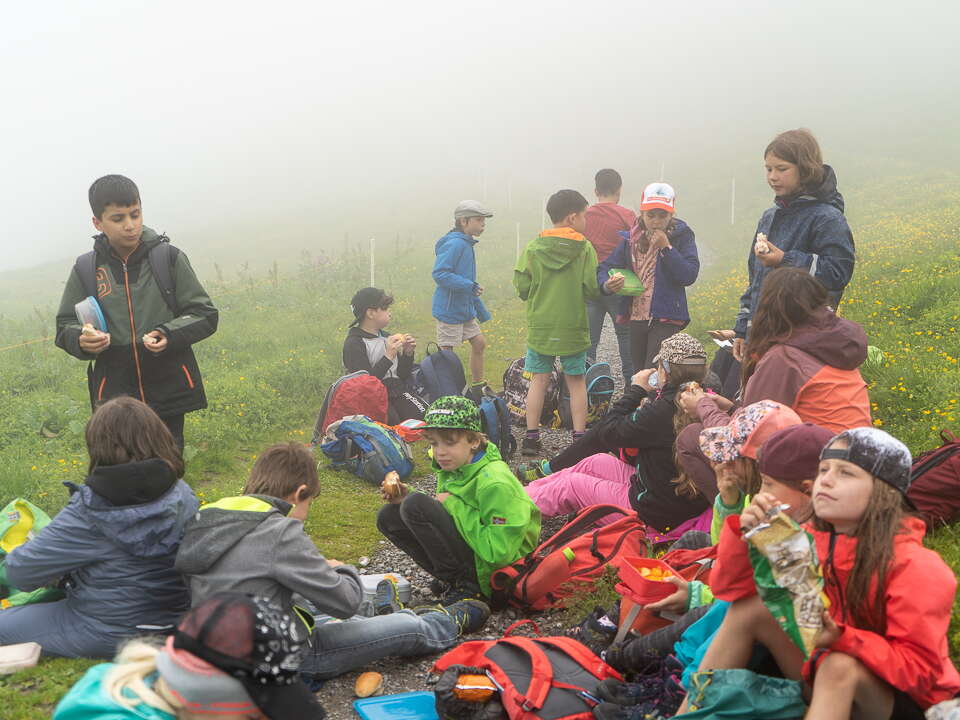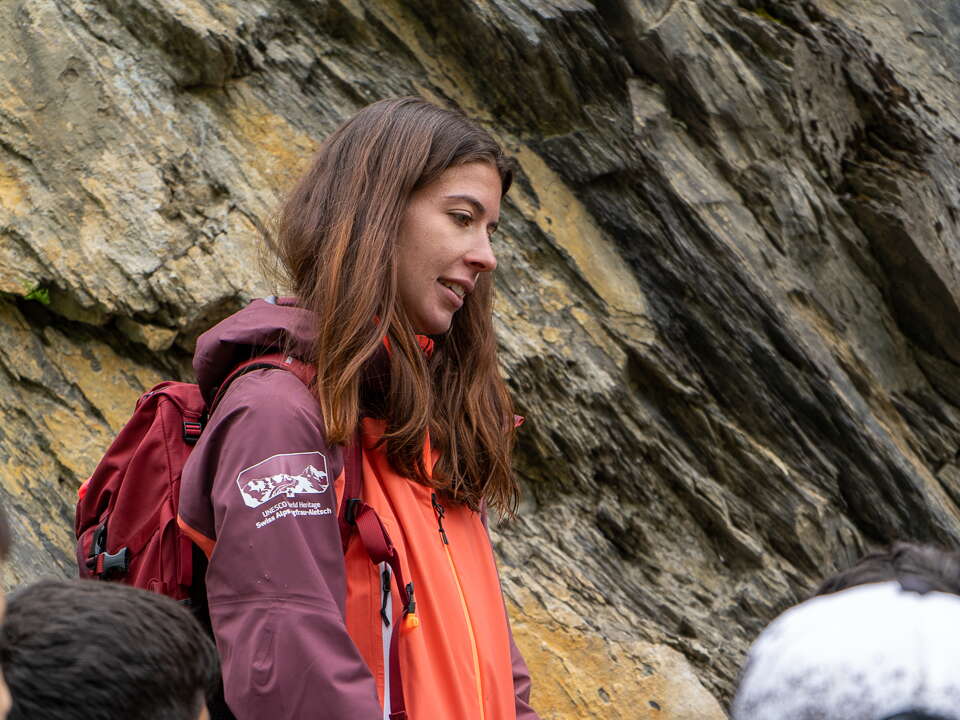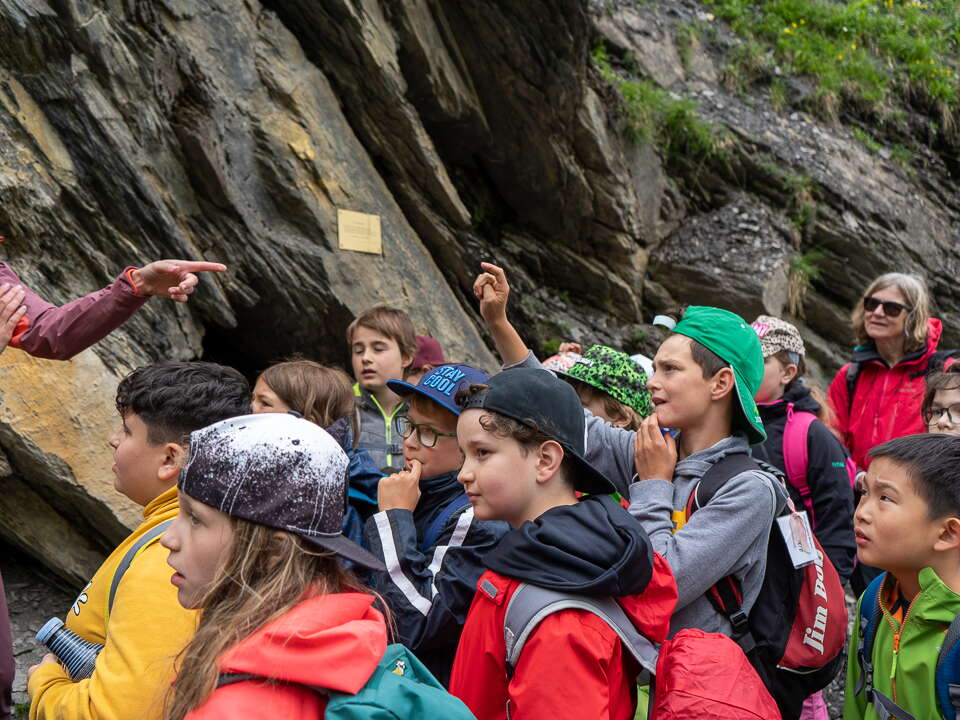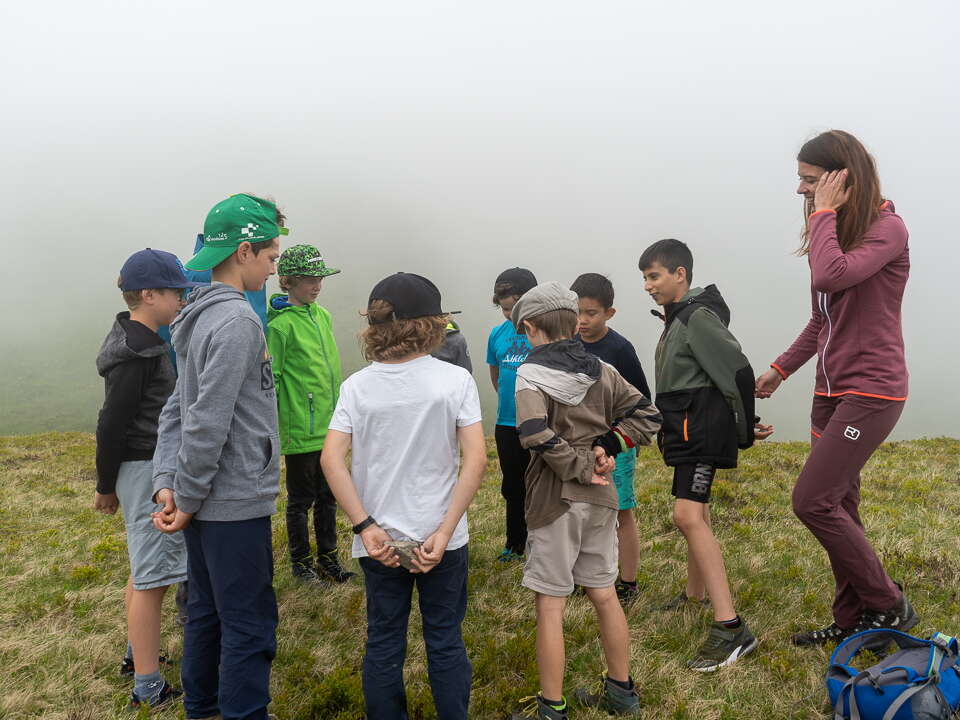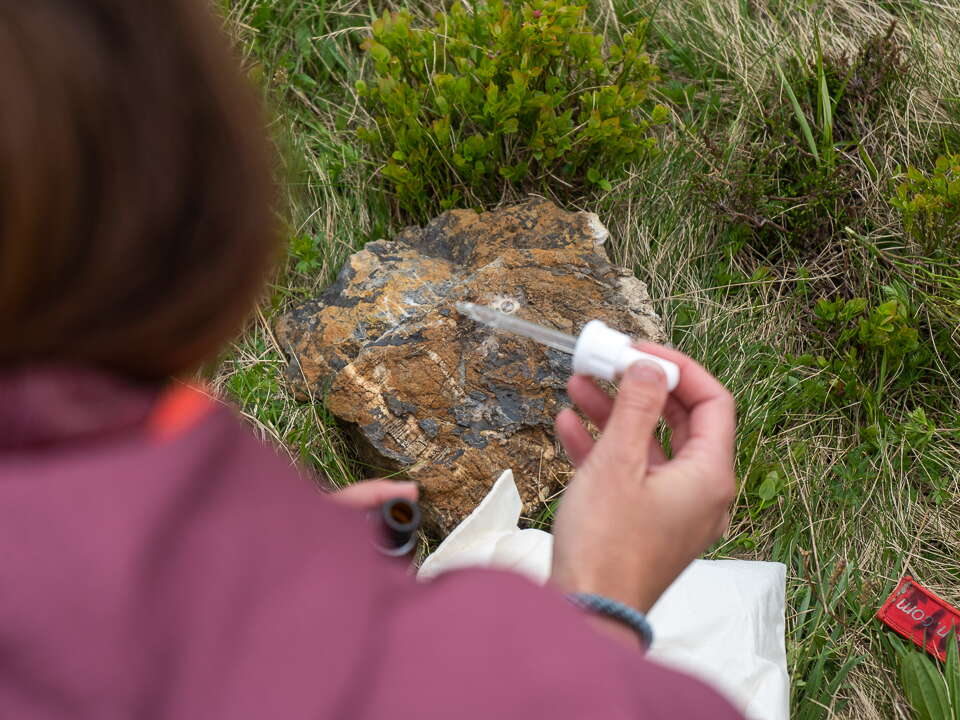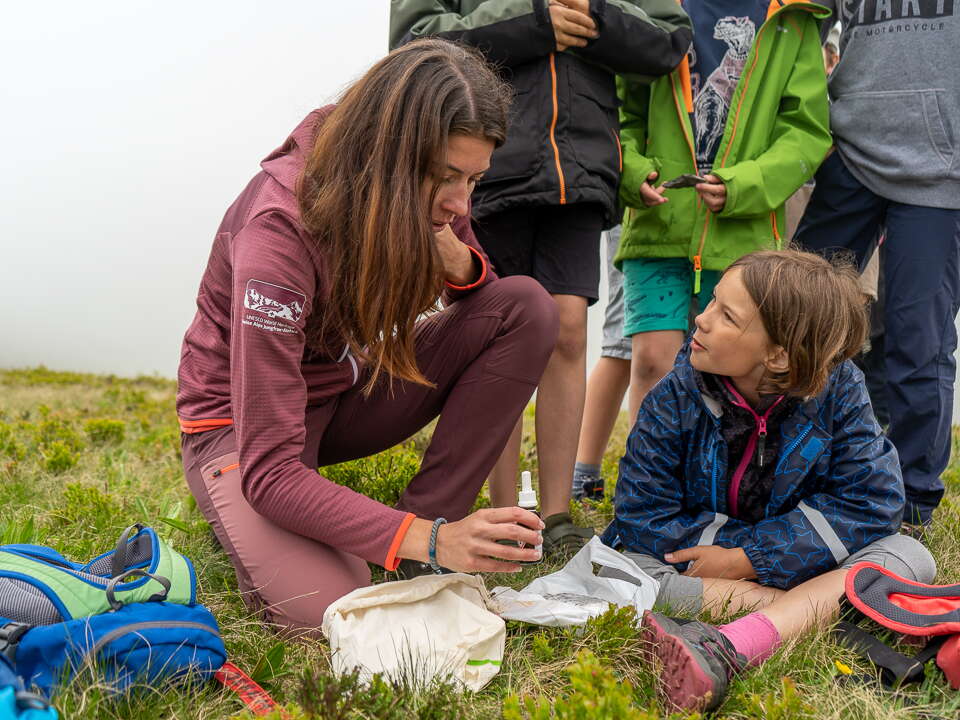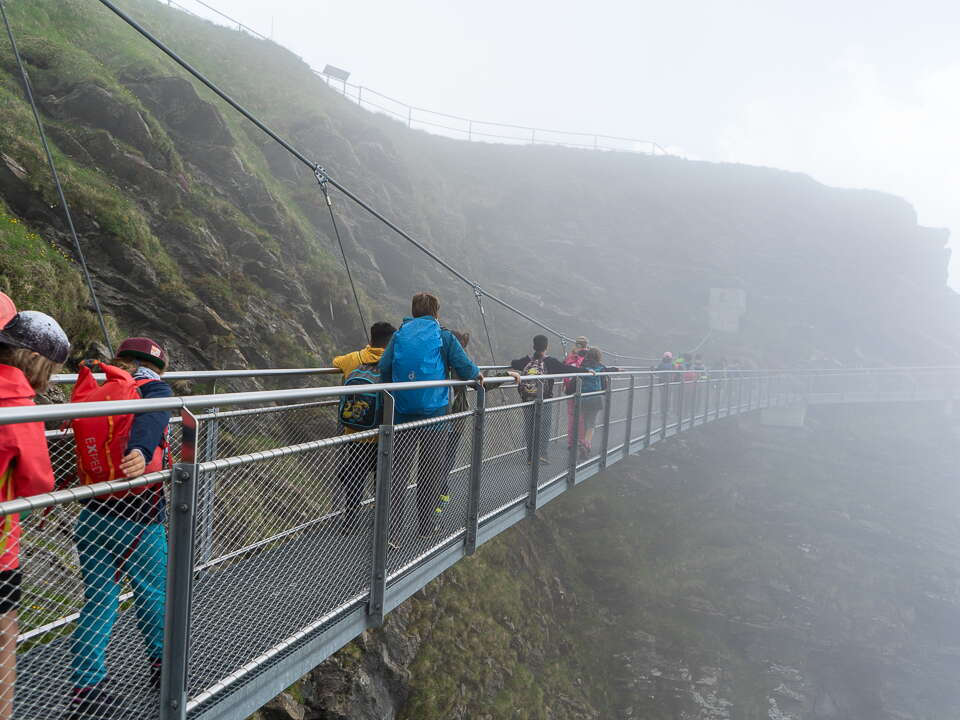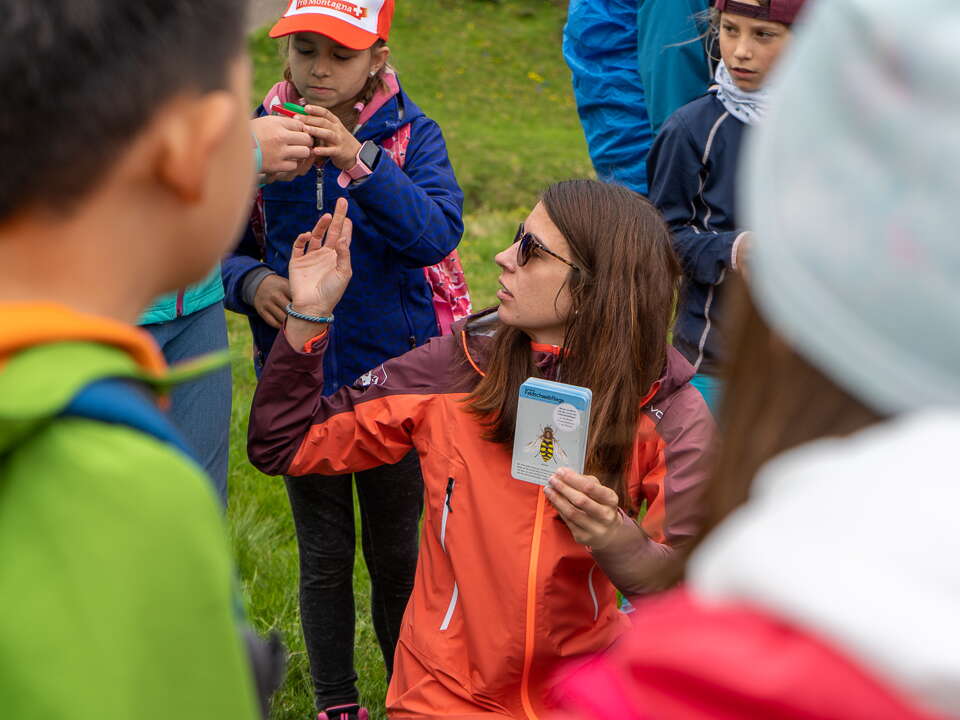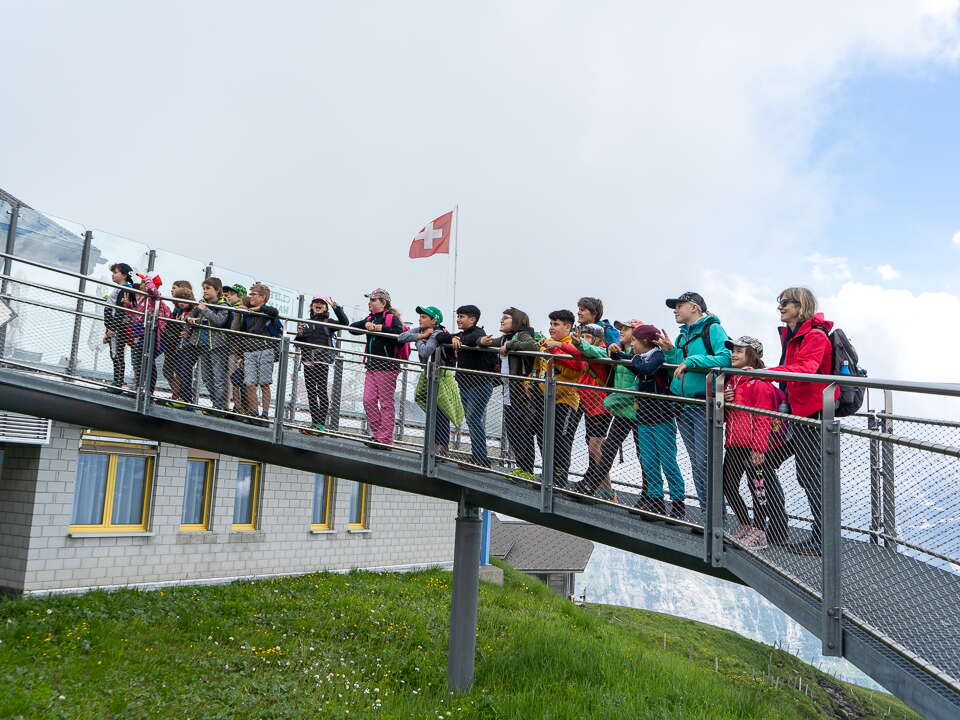Out and about with
Alessandra Lochmatter from the UNESCO World Heritage Foundation SAJA
"The coolest classroom"
It's noisy on the train. No wonder, two classes from the Matten school are on their way from Interlaken to Grindelwald. They are both taking part in an excursion organised by the SAJA Foundation to the UNESCO World Heritage Site Swiss Alps Jungfrau-Aletsch. I am accompanying class 3/4 b, which is on the road today with Alessandra Lochmatter. The 21 pupils aged 9 and 10 are full of anticipation. The teachers Marietta Briner and Claudia Eymann are also looking forward to "the coolest classroom in the world", as the Foundation writes in its brochure on education. And the weather is also playing along for the time being.
"We are in the Champions League"
From Grindelwald, the journey continues by PostBus to Grosse Scheidegg. Alessandra Lochmatter greets the class in her distinctive Valais dialect. "Do you understand me?" The pupils nod. "Where are we?" the 29-year-old wants to know - and spreads out a map on the floor. And then: "What is a world heritage site?". "A particularly beautiful place that needs to be protected," says one pupil. A good answer. UNESCO says that some old buildings and special landscapes are part of the heritage of the entire world. They should be treated well so that people in the future can still enjoy them. "Our world heritage is unique, diverse and inspiring," says Alessandra Lochmatter, listing important criteria that the area on Valais and Bernese soil had to meet in order to be included as a world heritage site. "It is the highest distinction. We are in a league with the Galapagos Islands in Ecuador, Yellowstone National Park and the Grand Canyon in the USA or Australia's Barrier Reef. We are in the Champions League," she says, not without pride. But many people don't know that. When the UNESCO World Heritage was briefly discussed at school before the excursion, most of the pupils were not aware that they had a World Heritage site on their doorstep.
Of sycamores and Sudeten butterflies
"If you see litter on the way, please take it with you. We can then dispose of it on the ridge," says Alessandra Lochmatter, giving the school class another task to do. Then the hike can begin. After a few minutes we make our first stop. Alessandra Lochmatter presents pictures of some of the plants and animals that are at home in the World Heritage Site. For example, the Sudeten butterfly. The subspecies of the Sudeten ear butterfly Erebia sudetica inalpina, to be exact. It lives in only one place in the world, namely Grindelwald. Its habitat is threatened by agricultural overuse and underuse. With management adapted to the needs of the butterfly and scrub clearance actions, its habitat is being enhanced so that it will hopefully spread and become more common again. Speaking of actions: Sycamore planting campaigns also take place regularly. Interested farmers are provided free of charge with the material for planting and securing sycamore maple offspring (small trees and posts). The black grouse is one of the endangered animals in Switzerland. Alessandra Lochmatter tells us about the courtship dances of the black grouse, which often last for hours. An impressive spectacle - to be observed every spring in the UNESCO World Heritage Site Swiss Alps Jungfrau-Aletsch.
Global warming - and the consequences for the marmot
We hike on. From a distance we hear a whistle. "A marmot," a student guesses correctly. "What's the marmot's problem if it keeps getting warmer," Alessandra Lochmatter asks the group? The hands stay down - and so the biologist immediately follows up with the answer. "In summer, marmots have to eat as many fat reserves as possible for hibernation. But when it's too hot, they stay in their burrow during the day because they hardly sweat and would quickly overheat on warm days." The unpleasant consequence: the fat reserves are not sufficient in winter and the animals starve to death.
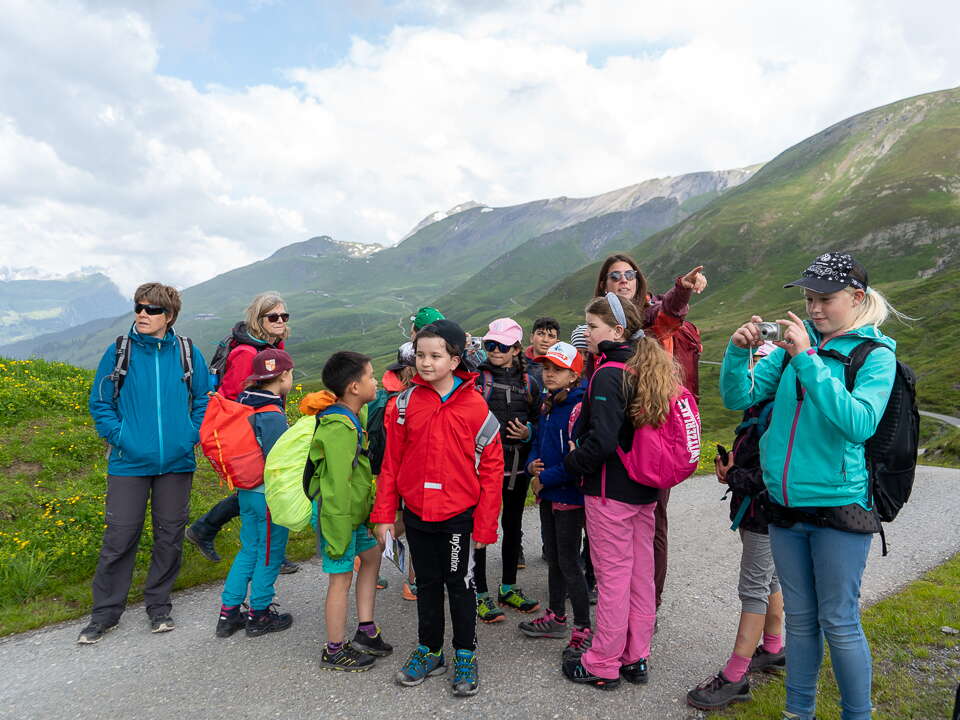
Frightening glacier retreat
Class 3/4 b from Matten is a class like any other. With pupils who raise their hands every time they are asked a question. With pupils who never speak up. With pupils who always walk in front next to the guide. With pupils who like to drop back unobtrusively. With attentive and dreamy pupils. But when it comes to the topic of glaciers, they are all ears. Especially when Alessandra Lochmatter tells them that a hundred years ago the Grindelwald glacier reached all the way down to the village. For the pupils, global warming is suddenly visible. That is more impressive than reading in a book that the glaciers are receding x metres every year. They also learn a lot of other interesting facts about glaciers. For example, how it is built - and what would change if we suddenly had no more eternal ice.
Rain protection instead of sunscreen
Just a moment ago, the pupils were rubbing on sun cream, now they suddenly have to get rain protection out of their rucksacks. A quick change in the weather, as is so typical for the mountains. Fortunately, it is not much more than a drizzle. We will learn later on in our excursion that storms can have bad consequences.
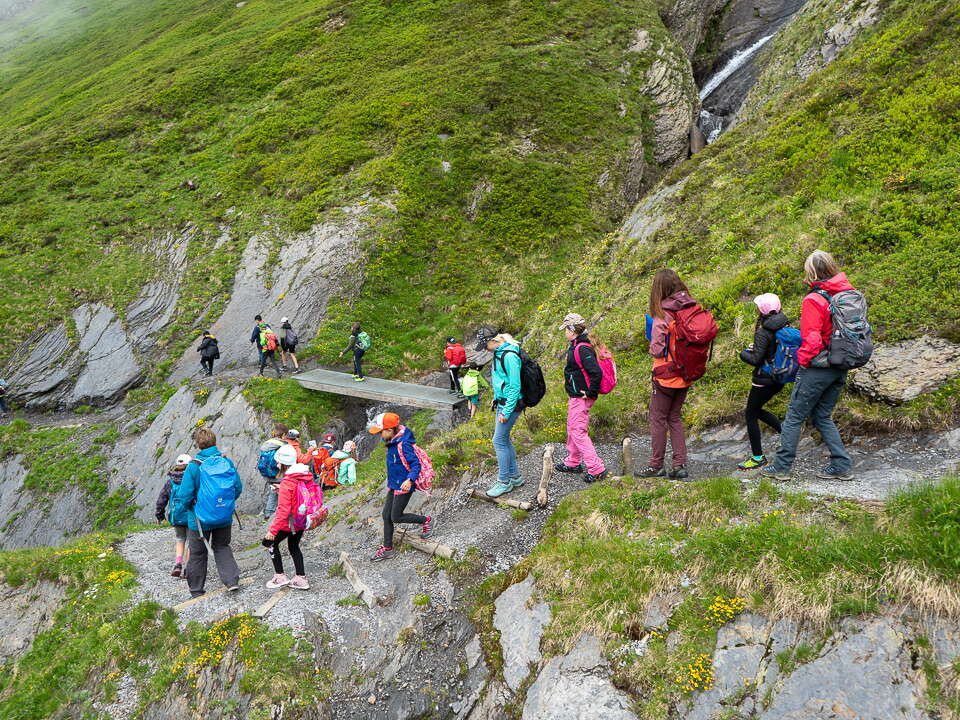
Diverse flora
For now, however, the focus is once again on the plant world. "What plants do you know?" asks Alessandra Lochmatter. "Gentians, firs, dandelions", the answers are complex. So far so good. But why do gentians have such large, strikingly coloured flowers? Why do orchids smell like vanilla or chocolate? "To attract insects, to be pollinated by them," the biologist explains. "And when it rains, gentians close their large flowers. The ideal protection." Yes, it is a miracle of nature how nature adapts to the environment. This also applies to the animal world. For example, hoverflies disguise themselves as bees or bumblebees to make the enemy think they have a stinger. Just as ordered, a hoverfly gets caught in the tippet of a schoolgirl. Like a biologist, Alessandra Lochmatter pulls out a magnifying glass from her backpack and catches the hoverfly. And so it wanders from hand to hand of the pupils - before it is released back into the wild. "Do you remember what I told you about the marmot?" asks Alessandra Lochmatter. The pupils nod. "This is Alpine clover, the marmot's favourite food. It contains lots of fatty acids, perfect for reserves in winter." But when summers get too hot, even the best Alpine clover is of no use, as we learned earlier.
Lunch break in the fog
It has stopped raining in the meantime, but now thick fog is rolling in. I wanted to write about a picnic in front of the Eiger, but that's probably not going to happen now. Nevertheless, the Eiger North Face is the theme. And we also eat. Despite the bad weather. The pupils' hunger is too great. And as diverse as the UNESCO World Heritage site is, so is the pupils' lunch. Everything is available, from fruit to nuts, crisps, the usual sandwiches to ready-made, still warm menus. During lunch, a large bird suddenly circles in the sky. A bearded vulture? No, more likely a golden eagle. But before we are one hundred percent sure, it disappears again into the mist.
Unpredictable nature
With full stomachs, the group slowly starts moving again - only to stop in front of a stone plaque. "In memory of Albert Schlunegger" is one of the inscriptions. Curious as children are, they want to know the story behind it. Schlunegger was a Grindelwald skier and mountain guide. On 6 August 2000, he was walking with a group of Americans on a hiking trail in the First area when they were surprised by an unpredictable mudslide. Schlunegger and two Americans - a father and his only 12-year-old son - lost their lives. A sad example of how unpredictable nature can be.
Fascination with stones
"Until the next stop, everyone looks for a stone," Alessandra Lochmatter gives the pupils a task for the next section - and learns that she has to set tasks very precisely, because already the first pupils are dragging half boulders with them. "A small stone that fits well in the hand," she explains immediately. We leave the hiking trail and deposit our backpacks in a meadow. "Please form two groups and stand in a circle," says Alessandra Lochmatter after she has collected the stones. Now everyone gets a stone in their hand behind their back - and has to recognise their stone. If it is not, the stone is passed to the right. Until everyone has their stone back again. Afterwards, the stone is also used for an experiment. Alessandra Lochmatter drips hydrochloric acid onto each individual stone. If the stone reacts - i.e. if it foams - it is lime, otherwise it is silicate.
And what would you change?
The fact that the topic of sustainability has arrived in the minds of today's youth is evident at the last stop. "What would you change?" asks Alessandra Lochmatter. The students sit on a rock and bubble over with ideas: Not driving so often, going car-free for a week once a year, taking the train instead of the plane, using less water when showering, not using bamboo wood, buying local instead of exotic fruits, not consuming Nutella because of the palm oil, so that less rainforest is cut down, also putting fruits in the sales rule that do not conform to the norm. "A triangular apple would be cooler anyway," says one pupil.
Want a little adrenaline?
One last little climb and then we are on First. Here the Cliff Walk awaits the school class. In single file, the pupils dare to cross the cliff walkway. This is only for those with a head for heights. I accompany the class for a short while - and then turn back.
Better than any textbook
Then we take the gondola back to Grindelwald. For some pupils, this is the first gondola ride in their lives. Accordingly, they understandably emphasise it when asked about the lasting impressions of this day. And what else? "I liked the nature and the mountains," says Melissa. The 10-year-old is also concerned about the receding glaciers. That seems to be what the class is most concerned about. Anouk (10) and Iris (9) also mention this. The former is also impressed by the stories about the Eiger North Face. Lou (10), on the other hand, was taken with the experiment with the stones, the Cliff Walk and the playground in Grindelwald, where the pupils stopped for a short break before returning by train. Adriana (10) raves about the gondola ride, the hiking, the train and post bus rides and lunch. And that she learned a lot today. The pupils agree on one thing: learning in nature is more fun than in the classroom.
About the person
Biologist Alessandra Lochmatter has been working for the UNESCO World Heritage Foundation SAJA in Naters for 4 years. She is responsible for the enhancement and conservation of the natural and cultural landscape as well as research and monitoring. She also helps with environmental education. This includes accompanying around 15 school classes per year on excursions in the World Heritage area, including the Jungfrau Region.
More information
Information on Education for Sustainable Development in the UNESCO World Heritage Site Swiss Alps Jungfrau-Aletsch
Photos: Salome Näf
Story: Raphael Hadorn
Summer 2022
Contact
Grindelwald Tourismus
Dorfstrasse 110
Postfach 124
CH-3818 Grindelwald
Tel. +41 33 854 12 12
info@grindelwald.swiss
![]()



